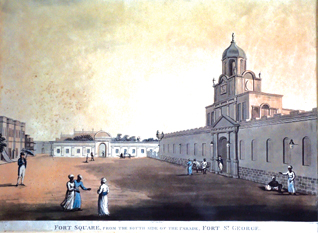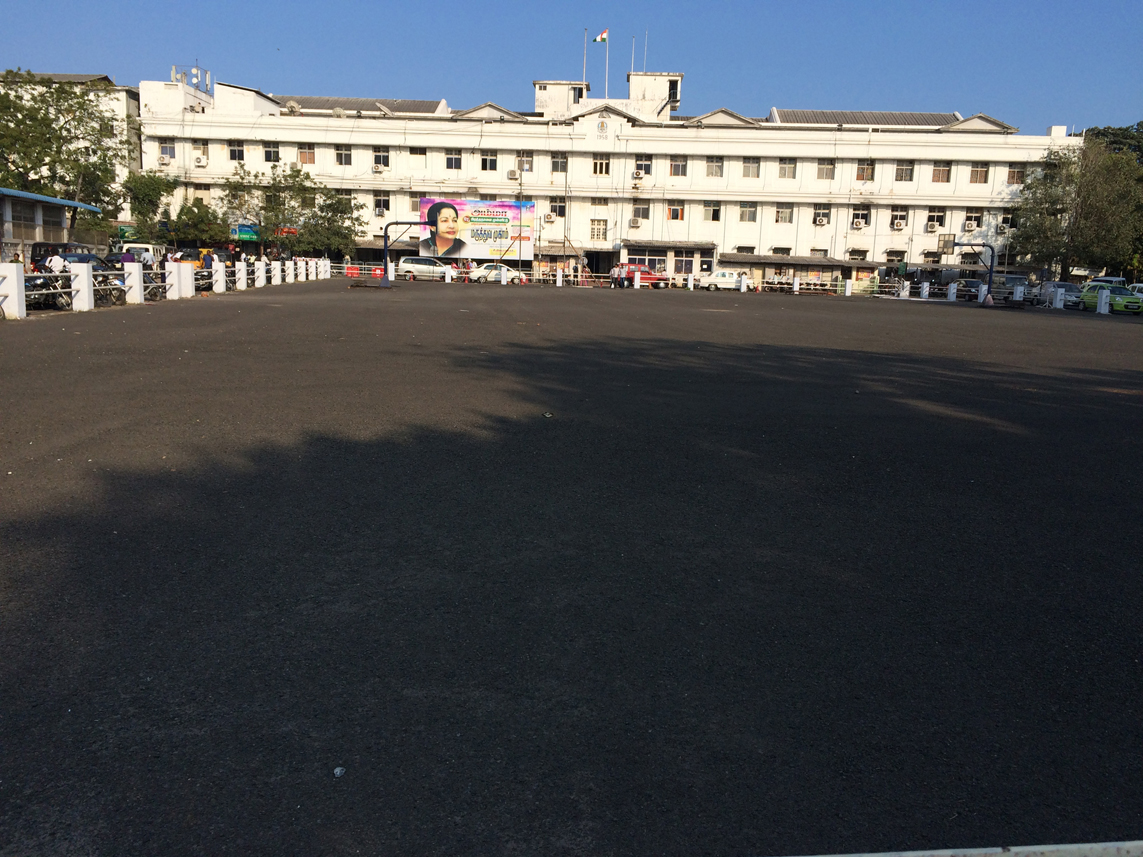
West Face of Fort St George, and Parade Square by Francis S. Ward, 1785.
One of the predominant features of Fort St George, and which shows that the Fort always had a strong army presence, is the Parade Square, known variously in history as the Parade, the Parade Ground, Barracks Square and Conrwallis Square. You just cannot miss it. As you walk to the rear of the Assembly building, it immediately strikes the eye. Cordoned off and now macadamised, its emptiness cannot be ignored for it presents a sharp contrast to the rest of the Fort which is mostly taken over by cars, police vans and two wheelers. Surrounding the Parade Square are some very handsome buildings.
That some kind of a parade ground existed in the Fort from at least the 1670s is evident when you read the accounts of various ceremonial occasions. Thus when Elihu Yale hoisted the king’s flag for the first time on the Fort ramparts, the garrison soldiers performed an “orderly march round the Fort” and then “drew round within the Fort.” In his Story of Fort of St George, Lt Col D.M. Reid throws some light on the initial days. The Fort was restricted to what was called Fort Square, the area currently occupied by the Assembly and Secretariat. To the rear of this developed the Parade, a long and narrow piece of ground that was hemmed in by houses on all the other three sides. Parade Square acquired its present contours following extensive renovations to the Fort in 1762 by which time most of the houses surrounding it were demolished. These had in any case suffered extensive damage during the French siege of the 1750s.
We get a reasonable view of how Parade Square looked in 1785 from Francis Swain Ward’s depiction of it in his The Parade and the West Face of Fort St George. The notes accompanying it state that the right side of the picture is the western face of the Fort. The tall domed structure, almost a Catholic cathedral in its design, no longer stands. It was in fact a street away and marks the location of Portuguese Square where the Namakkal Kavignar Maligai presently stands. This domed multi-storied structure was once the Court House in which civil and military prosecutions were carried on. In the same picture, the southern and the northern faces of Parade Square have colonnaded and pedimented buildings, all built in the classical style, and these have survived till date. The army and its various functional units occupy all of these.
The western face, diametrically opposite the rear of the Assembly, has barracks that were built late in the 19th Century. With that, Parade Square opened out to barracks on three sides and it came to be known as Barracks Square. The Cornwallis cupola and its statue of the Governor General stood close to the rear wall of the Assembly building on Parade Square and faced west from the early 1800s till 1905. Parade Square was therefore also referred to as Cornwallis Square. The unveiling of the statue here was a gala event, as we have noted earlier. So also was the arrival of Cornwallis in 1805 when, having assumed charge for the second time as Governor General of India, he visited Madras, en route to Calcutta. On that occasion, he addressed the troops and Madras citizens at Parade Square.
The ceremonial that accompanied these events was in marked contrast to the night of August 23, 1775 when Sir Robert Fletcher, Commanding Officer, gave instructions for the arrest of the Governor Lord Pigot. The latter was imprisoned by Col Stuart and conveyed to St Thomas Mount. Pigot’s sympathiser and son-in-law, Claud Russell, also a member of the Madras Council, records that Parade Square that night was a picture of confusion. Lit by a full moon, it had army officers, Europeans and natives walking hither and thither even as carriages blocked the entrance to the Square. The garrison was sharply divided and the troops mutinous but eventually the anti-Pigot faction had its way. The Governor died a mysterious death a year later at St Thomas Mount while still a prisoner.
Parade Square was never paved over till at least the 1950s. It remained a well-beaten piece of earth and, given that a regiment had always been quartered in the Fort for over two centuries, was used for marches and parades. P. Unnikrishnan, the former Managing Director of Binny’s, remembers Parade Square in the 1930s when his father was Law Secretary, Government of Madras. He would often walk up to the Fort from the Madras Christian College School, then in George Town, to go home with his dad in the latter’s car. He states that a parade was held every alternate day in the Square and it was a grand spectacle. Despite it being used for parades, the residents of the Fort cut across the Square as and when needed and this led to a clearly demarcated track emerging over the years.
Several accounts of ceremonial parades conducted here have survived over three centuries. A ceremonial parade was held in August 1801 to welcome “His Excellency Meer Alam Bahadar, ambassador from His Highness, the Subahdar of the Deccan”. The visitor came in through St George’s Gate and was received with presented arms by His Majesty’s 51st regiment, “which then formed a street from the gate to Parade Square”. Thereafter, a street was formed by the 2nd Division 1st European Regiment and the Madras Militia under Major Taswell. A salute of seventeen guns was fired and the troops continued to present arms till the distinguished visitor left the Fort. Another account dates to September 13, 1807, when the appointment of William Petrie to the post of Governor was announced. A salute of 19 guns and three rounds of “musquetry” were fired from the troops of the garrison, all of whom had assembled on Parade Square.

A view of Parade Square from the west, looking towards the Secretariat. haps, even high-rises.
Mrs. Penny in her book wondered as to how the Englishmen “ever survived such an ordeal by fire, as a parade in full dress under an Indian sun must have been.” Evidently most did, but there are several accounts of backsliders as well, all of whom were court-martialled. On July 14, 1837, Capt. John Mahon of HM 63 Regiment of Foot was tried by order of Maj. Gen. John Doveton for having absented himself from parade on June 22, despite having been admonished by his senior officer for a similar misdemeanour on an earlier occasion. He was exonerated on all charges on a technicality much to Doveton’s distress. Far worse was the charge against Capt. John Arnaud of HM 34th Regiment. He had been arrested for some indiscipline and, while under incarceration, “appeared in an un-officer like dress when the regiment was on parade” and stood there and looked on. He too was acquitted of this charge.
Being drunk on parade was clearly an unpardonable crime. The trial of Lt. John Winrow was held from January 13, 1817 and dragged on for some time. He was of the 1st Battalion of the 30th Regiment and was tried for “shameful and unofficer like conduct, in appearing on the general parade of the Battalion, in a state of intoxication, on the evening of the 30th December, 1816.” Clearly, his New Year celebrations had begun early.
The judgement was curious to say the least. While it found him guilty of irregular and improper conduct at the Parade… when not perfectly free from the effects of liquor, it acquitted him of the charge of “shameful conduct in appearing there in state of intoxication.” Lt. Winrow lost two steps and was asked to take his place immediately behind the two lieutenants who till then had stood next to him. The order, though entered into the book, was never implemented, for Winrow had died even when the trial was in progress.
Parade Square is now cordoned off for its own safety, for if opened up it will be filled with Government vehicles and, perhaps, even high-rises.
|

